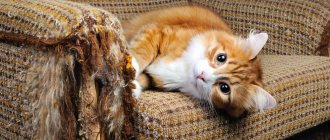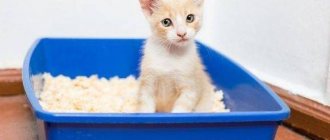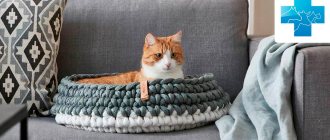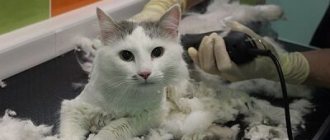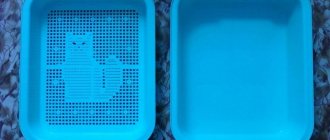Share on social media networks:
Anti-vandal wallpaper from cats is the dream of almost all owners of purring pets - it is an excellent protection for your walls and wallpaper. The cute little furball is growing and starting to show needs, and sharpening his claws is one of them. This is inherent in nature at the genetic level, so trying to wean an animal from sharpening its claws is a useless exercise; this is only possible if you simply remove the cat’s claws. Veterinary clinics provide similar services, but felinologists unanimously say that this is not worth doing if you really love your cat. Declawing an animal is painful and stressful. Therefore, it is better to find another way out of the situation. In this article we will talk about the main reasons why a cat pulls wallpaper, and we will also talk about what to do to prevent this from happening.
The cat is in the house. Problems or joy? How to protect walls
How to decorate the walls so that the cat cannot damage the walls? Little children, begging their mother for a cat, think that all that awaits them is purring and funny games. An adult, when getting a pet, must be aware that a cat means daily feeding, cleaning the litter box, hair everywhere, broken cups and overturned flower pots, vaccinations and sterilization, illnesses and many other “charms”, including scratched furniture, and peeled wallpaper.
But not everything is so sad. Firstly, cats, if you love them, with their affection and energy are able to neutralize all the negative aspects of their coexistence with humans. And secondly, now there are many all kinds of devices and life hacks that can make our lives easier: special gloves for combing fur, filler for trays that absorb odors, nail clippers, scratching posts, and even anti-vandal cat wallpaper.
What is this?
Anti-vandal wallpaper is a finishing material of increased strength. There are several types of anti-vandal coatings, each of which has its own individual characteristics, namely increased resistance to certain influences. Despite the name, wallpaper will not be able to protect against any damage; vandal-proof wallpaper is only provided with greater density and a protective coating, unlike conventional paper or non-woven fabrics.
Why do cats sharpen their claws?
Why does a cat tear wallpaper, furniture and other objects that come under its paw? A cat is, first of all, an animal with instincts and needs, because a person has no doubt that manicure and pedicure are necessary. This is not only for the sake of aesthetics, but also for the sake of hygiene and convenience. Regarding the cat, the situation is somewhat similar. A cat scratches wallpaper for several reasons.
- The claws grow and peel, which causes discomfort in the cat. For the cat family, claws are a formidable weapon; they help them hunt and defend themselves from enemies. And weapons must always be in combat readiness. A cat's claws grow all the time, but at home the animal does not have the opportunity to use them for their intended purpose. Therefore, they lengthen and begin to exfoliate. When this causes inconvenience to a cat, it looks for something to sharpen them on and tries different surfaces. Most often, such “manicure files” are upholstered furniture, carpets or wallpaper.
- There are special glands on the front legs; they are located between the pads of the toes and secrete secretions. As we know, smell for animals is a unique way of transmitting information. The cat, sharpening its claws on the surface, leaves its scent, and thus marks the territory, informing its relatives that it is the master here and should not intrude.
- This is a kind of warm-up and gymnastics for the cat. Surely a cat could, without straining too much, sharpen its claws on the carpet? But no, he needs to stretch up to his full length, arch his back and work his paws well. Thus, the animal stretches its muscles and ligaments, and, perhaps, remembers: “what is it like to extend its claws into prey?”
- Stress relief. Feline scientists suggest that in the process of sharpening their claws, cats relieve stress and consciously release negativity after some unpleasant or frightening situation. Sometimes pets do this simply out of boredom.
So, we figured out the nature of this phenomenon. Now no one will doubt that by stripping furniture and wallpaper, the cat is not taking revenge on you for untimely cleaning of the litter box, but is simply obeying its nature. Next, you need to figure out what to do to prevent your cat from tearing wallpaper and furniture, and how to effectively protect your property from the paws of a furry robber. Let’s make it clear right away that we are not considering the “beat” option. This is not humane. In addition, the cat is unlikely to understand why he received a hit on the scruff of the neck. This will only lead to the animal becoming embittered and taking revenge on you.
What is the most durable cat wallpaper?
The most durable wallpapers include:
- Reinforced with polymer fiber (non-woven, cork for painting);
- Covered externally with a thin layer of high-strength vinyl on a 100% cotton fabric backing (heavy vinyl);
- With Teflon protective film (textile commercial).
Effectively cope with the function of protecting against pet claws:
- Non-woven wallpaper made by hot stamping with laser heat treatment;
- Glass fiber reinforced wallpaper.
Withstand repeated attacks by animals on their integrity. They are easy to care for by removing dust and dirt with a damp sponge. They can be painted. Immediately after sticking, the animal will try to sharpen its claws on them. But after a couple of days it will stop doing this, leaving only a few scratches on the papered wall.
How to stop a cat from scratching furniture and wallpaper?
How to stop a cat from tearing wallpaper and jumping on walls? To solve this problem, you just need to create conditions for the cat so that he realizes his instinct in the right place.
Tip 1
You should buy it at a pet store or make it yourself a stable scratching post, then the cat will leave your interior alone. Although, in order to switch the fluffy to a new “object”, you need to make an effort:
- First, buy or make the right scratching post yourself. It is desirable that it be tall (no less than the length of the entire cat with its paws extended upward).
- Typically, such devices are wrapped in sisal (a coarse natural fiber twisted into ropes) if the scratching post is shaped like a column. Or it is covered with sisal fabric, if the scratching post is in the form of a plank.
- The device must be stable, otherwise, if it falls, the cat will be scared and will avoid the scratching post. Ideally, it should have wall or floor mounts.
Important! If you love and pamper your pet, then you can purchase a whole complex of posts, shelves, houses, ropes and toys. The elements of this design are covered with sisal. The cat can not only sleep, play or climb up and down, but also sharpen its claws.
Tip 2
If your cat scratches wallpaper and furniture in a certain place, then you should imitate the same surface on a scratching post (glue it with a piece of the same wallpaper, pull fabric on top, like on a sofa, and so on) and place such a scratching post near the place where the cat comes to scratch. claws When the animal switches to this device, it can be moved gradually to the desired place.
Tip 3
If, despite your efforts, the cat tears the wallpaper and continues to scratch property with its claws, it needs to be weaned off. How to treat wallpaper to prevent the cat from tearing it? There is a special spray for cats - they need to sprinkle it on their favorite place of “hooliganism” (sold in pet stores). Alternatively, a vinegar solution or citrus tincture can be used.
Important! In addition to the unpleasant aroma for a cat, straws, strips of double-sided tape, foil or a rustling film glued to the surface can also deter scratching wallpaper. Some people recommend clapping your hands loudly or splashing water on the cat when he begins to sharpen his claws in the wrong place.
There are even special installations with a special spray and a motion sensor that help wean the cat from “vandalism.” But this is an expensive pleasure.
Paint it so it's pleasing to look at
Painting is a surefire way to protect your walls from claws. Designers advise combining colors to dispel the boredom of the interior:
- Make the border below the midline for classic styles. You can use stucco moldings for styling.
- Place the border above the center line for a creative design. This option is suitable for a children's room.
- Divide the wall vertically - “draw” with tape and paint many narrow strips or one wide one.
- Make color inserts, decorating them with frames or other creative ways - rhombuses, squares.
- Highlight the accent wall with a bright color (red, orange, light green, turquoise), and leave the rest neutral.
- Draw a contrasting strip along the entire perimeter of the walls, make several horizontal stripes of the same color, but in different shades (gradient effect).
- Paint the walls with slightly tinted white paint. Then apply stains with dark paint using a sponge dipped in water for water-based compositions or in white spirit for oil-based ones.
How to interest a cat in a new scratching post?
- A small kitten should be immediately accustomed not only to the tray, but also to the scratching post; do not let him tear up wallpaper and furniture, otherwise it will become a habit.
Important! If you have adopted an adult animal from the previous owner, take his scratching post to which he is accustomed, otherwise you risk your furniture.
- Install the device in a visible place, and during the game provoke the cat to cling to its surface with its claws.
- You can simply lead the kitten to the scratching post, gently grab it by the front paws, press the pads with your fingers to release the claws, and show it what to do.
- In addition, you can hang a tempting toy on top of the installation so that the pet, in attempts to get it, will climb on the surface of the scratching post. This should be done 3-4 times a day, unobtrusively, trying to provoke the desired process with a game.
- Many owners recommend using an additional bait - catnip or valerian.
Important! When the cat understands what is required of him and begins to sharpen his claws in the right place, reward him with treats at first to consolidate the result.
Some tips for choosing anti-vandal wallpaper
1. In houses with small residents, it is better to glue non-woven wallpaper, which should be covered with washable acrylic dyes.
2. For painted wallpaper, you should leave a small container (? 20 ml) with paint in reserve, which will be useful for eliminating deep damage.
3. Fiberglass and contract wallpaper are the best option for rooms with pets that sharpen their claws and like to climb vertical surfaces.
4. Non-woven or laminated options are suitable for the kitchen, since greasy stains will not “eat into” them and can be easily removed from the surface during cleaning.
5. For the bathroom and toilet, you should choose wallpaper with a moisture-resistant structure, especially the backing (base) layer.
What can I do to prevent my cat from scratching the wallpaper? Cat manicure
To prevent the cat from tearing the wallpaper, that is, he has less need to sharpen his claws, they need to be trimmed in time:
- If you don't want to do this personally, just take your pet to a groomer - he will do it quickly and inexpensively.
- If you want to do this procedure yourself in order to save your time and money, then you need to purchase a special tool, since ordinary scissors and wire cutters are not suitable.
- Special nail clippers are sold in the form of specially shaped scissors, nippers or “guillotines”. The tool must be sharp and of high quality so as not to cause inconvenience to the cat.
Important! You should know that not the entire claw can be cut off, but only the tip, since in the middle of the claw there are blood vessels and nerve endings - they cannot be touched.
- If you are doing this procedure, sit by the window so that in good lighting you can see the claw through the light.
- The claw is cut along the edge of the blood vessel at an angle of 45 degrees. Use a hard file or a block to smooth out the cut so that there are no nicks left.
Important! Usually it is enough to carry out the procedure once a month. Although this is all individual. If you pay attention to the pigmentation of the claw, the light ones grow faster than the dark ones.
- Nail trimming should be done in a calm environment. You can even do it more than once if the cat doesn’t really like it.
- If the animal flatly refuses to sit still, then you can swaddle it in a towel, exposing one paw at a time. If you don’t want to suffer, get your nails trimmed by a specialist.
Design ideas
Under the brick
Finishing with imitation brickwork is suitable for decorating a room in a modern, Scandinavian, Provence or loft style. As a rule, a brick wall decorates only one wall or part of it. The textured surface goes well with other types of finishes, such as plaster or other coatings. Anti-vandal wallpaper can be non-woven or varnished. These types of finishing materials offer a wide selection of colors and textures.
Geometry
Geometric patterns can be in the form of an ornament or a textured pattern. Geometric shapes will decorate modern, Scandinavian, minimalist or high-tech design. Patterns can be presented in one form or another on all types of anti-vandal wallpaper. In the interior it can be combined with plain coatings or liquid wallpaper.
Flowers
A floral print can decorate both a classic interior and a design with a modern stylistic direction. A colorful image of flowers on a varnished surface will decorate a living room, bedroom or children's room. Non-woven vandal-proof fabric for painting can have a pronounced texture with a floral pattern. A large floral pattern can highlight some areas in the interior, combining the covering with plain types of wallpaper.
What can I do to prevent my cat from tearing up wallpaper and furniture? Anti-scratch
There is another answer to the question of what to do to prevent the cat from tearing the wallpaper. You can buy a newfangled device - special silicone caps. They are put on each claw and held on with special glue. Such anti-scratch products are sold both on the Internet and in pet stores. They are inexpensive.
How to use silicone nail caps?
- First you need to clean the claws from dirt using any disinfectant and a cotton pad.
- Next you need to trim the excess length, 1-2 mm.
Important! You should not be too zealous, as the cap will not hold well.
- By pressing on the pad, when the claw comes out, you need to try on the cap. If the length is too long, it can be reduced by cutting off the excess from the hole side.
- The cap should be secured with glue. You need to squeeze a drop of glue inside the cap so that it fills it by one third.
Important! To speed up the process, you can pour glue into all the caps at once.
- After this, you need to put the silicone pad on the claw and squeeze on the sides for 5-10 seconds. The same should be done with the remaining caps.
Important! Typically, “anti-scratch guards” are worn only on the front paws.
Useful tips for using silicone pads:
- It may happen that the cat will try to chew them off. Please be patient and use anti-scratches. Replace damaged ones with new ones. Be patient. Over time, she will get used to it and will not pay attention to them.
- These silicone caps come in different colors. It is recommended to use them for adult cats (6 months and older) who do not go outside and there is a risk that they will damage furniture and wallpaper or scratch children.
Important! Pets that have the opportunity to walk in the yard do not need nail trimming or nail guards. Old animals usually lose interest in sharpening their claws and scratching games.
- The caps should be replaced about once a month. They themselves will begin to fall off when the upper stratum corneum of the claw comes off.
Screens
If the renovation was completed long ago, and the animal appeared in the house later, you can choose the most convenient and practical option - buy plastic protective screens for the lower part of the walls. They can cover any surface, including doors, because they are quickly attached with double-sided tape and removed as needed.
On a note! Cats immediately lose interest in the walls and stop damaging them as their claws slip off the plastic.
Protective screen made of transparent plastic
Wallpaper resistant to cat claws
If you are the owner of cats or dogs, then you must understand that furniture, wallpaper and fragile things are the most vulnerable places in the apartment. Let's talk about wallpaper more specifically. During repairs, you need to take into account that cats can tear the wallpaper with their claws, large dogs can pollute the wallpaper while playing or just walking around the rooms. If you do not want to re-paste the wallpaper every year, you can use the following recommendations:
- You can wallpaper only the upper half of the wall, and in the lower part (at least a meter from the floor) use another type of finishing: paint, decorative plaster, artificial stone.
- Vinyl wallpaper is dense and durable. But in order not to attract the attention of your “predator,” the wallpaper must be pasted without flaws, so that not a single joint comes off, not a single edge sticks out.
- Liquid wallpaper is no longer wallpaper, but a type of decorative plaster. For cats, such a surface is unattractive as a scratching post.
- Special anti-vandal wallpaper. What it is? Such fabrics have high density and strength. They can be non-woven for painting, fiberglass (heavy-duty), contract vinyl wallpaper and vinyl wallpaper with lamination. All these types are able to withstand the pressure not only of animals, small children, but also of crowds of people, for example, in the corridor of an institution. The appearance is decent, there are many colors and patterns. They are, of course, more expensive than regular ones, but repairing walls every year will also cost you a pretty penny. It would be more practical to spend once on anti-vandal coating for walls against cats and not worry about the integrity of the decor for several years.
Painting and decorative plaster
Painted walls attract little animals, because they are smooth, even, without any snags, and it is impossible to tear off a piece from them. The only disadvantage of staining is the difficulty of preparing the base - the slightest irregularities will immediately catch the eye. If you don’t want to spend a long time and carefully leveling the walls, you can use decorative plaster.
Now there are plasters on sale with different textures and effects:
- flock;
- Venetian;
- bark beetle;
- fleece;
- lamb, etc.
Cats rarely pay attention to such coverings, but if you have a dog, you need to better monitor your pet's behavior.
Important! It is necessary to ensure that animals do not start chewing the plaster, because in this case there is a risk of poisoning.
Video material
Many lovers of “our little brothers” are at a loss and are looking for an answer to the question of what to do if a cat tears up wallpaper on the walls or damages other furniture. There are several options for action. The main thing is not to give up, not to hit your pet and look for an appropriate answer. In this article, you will definitely find the best option for yourself and your pet, which will not cause damage to your wallet, nervous system and will satisfy all the “cat’s” needs. You can also find anti-claw reviews on the Internet and get your own practical advice.
Tile and stone
An excellent way to protect walls from attacks by cats and dogs is to decorate with ceramic tiles. This material is not only suitable for the bathroom: many types of ceramics look great even in the living room, imitating stone, wood, metal, leather and other interesting materials.
Instead of tiles, you can introduce brick into the interior, especially when it comes to loft-style design. Artificial stone will also serve as an effective addition to wallpaper, plaster, paint or independent finishing - it has maximum hardness and durability.
Advantages and disadvantages
Cat owners highlight the following positive aspects of using anti-vandal wallpaper against cat scratches:
- long service life without external deformations;
- hiding defects in the form of scratches, holes;
- Possibility of use in premises for various purposes;
- no danger to the health of people and domestic animals;
- maintaining bright colors throughout the entire period of use;
- ease of cleaning;
- good room ventilation;
- the ability to cover the walls yourself without calling a specialist.
Most often, buyers of such products resort to the services of online stores.
Cat claw-resistant wallpaper is more expensive than regular wallpaper, but the savings on further cosmetic repairs offset the costs. Buyers also note that the choice of textures and colors is limited, and the stores offer a narrow range of products. Most products must be ordered through online platforms.
How to stick it yourself
The pasting process is practically no different from ordinary vinyl pasting. But in order for the work to proceed quickly and easily, and the result to please you with the quality of execution, you should adhere to the following steps:
- We prepare the equipment necessary for the work and calculate the required amount of material. You should know that the standard width is 106cm, and the length may vary by the manufacturer. When choosing glue, be sure to specify what types it is intended for. You may also need: a tape measure, a thin metal ruler, a pencil, a plumb line, a brush or roller, a wallpaper knife, a silicone spatula.
- Apply the adhesive mixture to the prepared surface. The walls must be dry, clean and without any major damage. Anti-vandal wallpaper is good because it does not require puttying the surface. It is sufficiently well primed for better adhesion of the canvas to the wall. The canvases are glued directly to the wall, without first applying glue to the paper web. To use materials sparingly, it is better to apply the glue with a roller rather than with a brush. A silicone spatula will help you easily get rid of excess air under the canvas.
- As a rule, they are glued end to end. If they have an ornament, you should adjust the pattern on several canvases in advance. It takes a day for the material to dry. After this time, you can trim off the excess.
To make the work look finished, along the perimeter of the room the upper joint is decorated with a ceiling molding, and at the base of the floor the sections are covered with a plinth.
If the selected type involves painting, then only after complete drying can the selected color be applied to them. The color can be diluted at home, but it will be better if the wall paint of the desired shade is prepared for you in a store using a special machine.
If painting the walls requires not one, but several cans of paint, you need to tint the entire volume at once so that the shades do not differ from each other. It is better to choose acrylic or water-based paints for anti-vandal wallpaper. They dry faster and do not have a strong chemical smell.
If one layer is not enough to achieve the desired tone, they can be painted several more times. Always remember that the chosen color will please you for quite a long time. Therefore, approach the choice of wall shade with all responsibility.
How to remove anti-vandal wallpaper from a wall
Sooner or later there comes a time when old wallpaper needs to be removed from the wall. They are very easy to remove. It is enough to wet the coating with warm water using a roller. And after 10-15 minutes they will easily move away from the wall.


